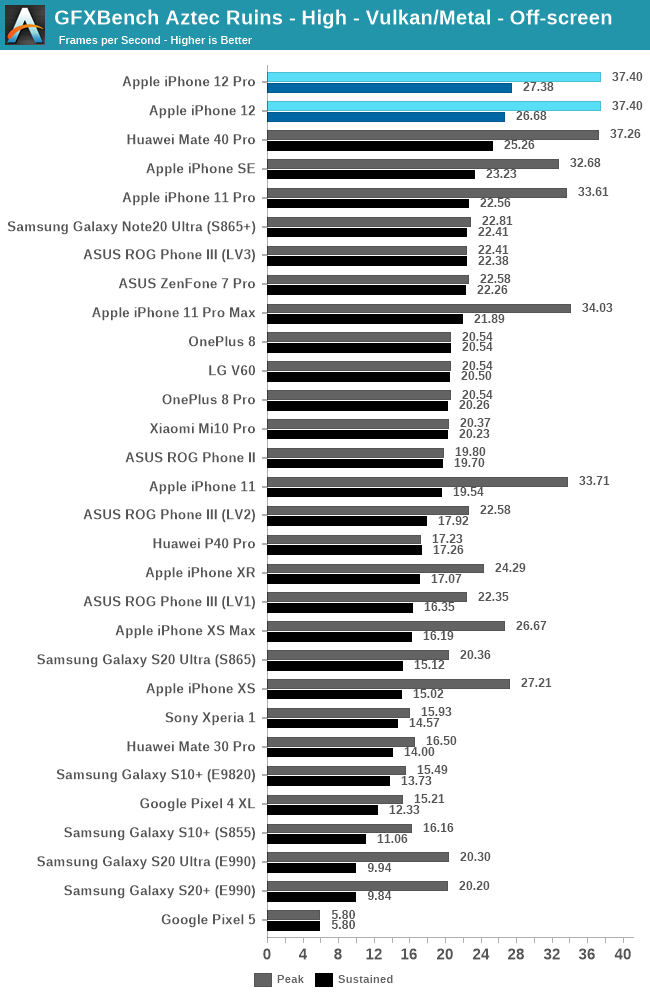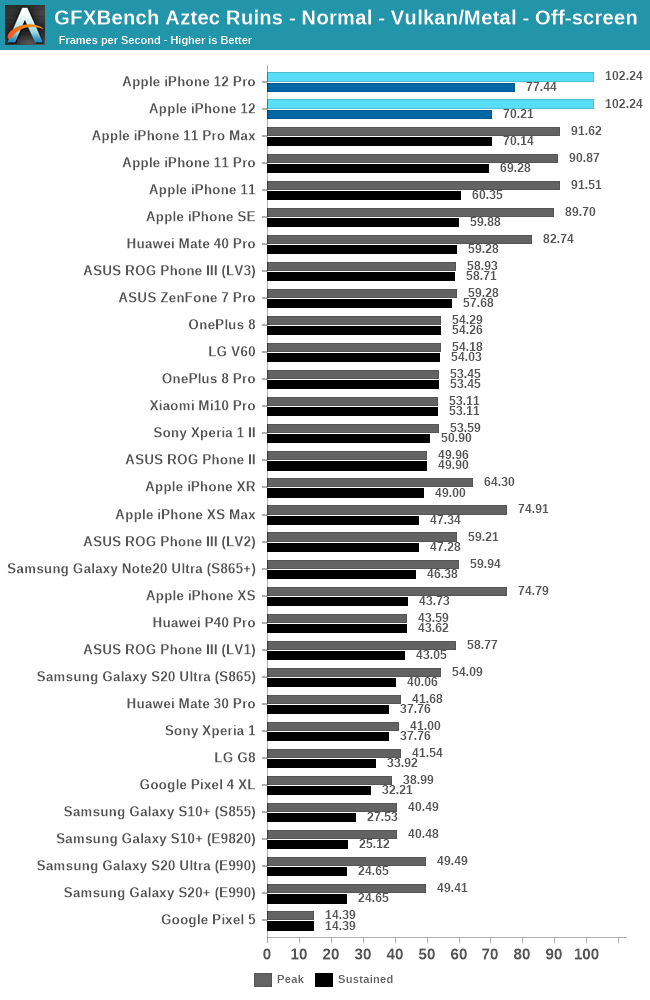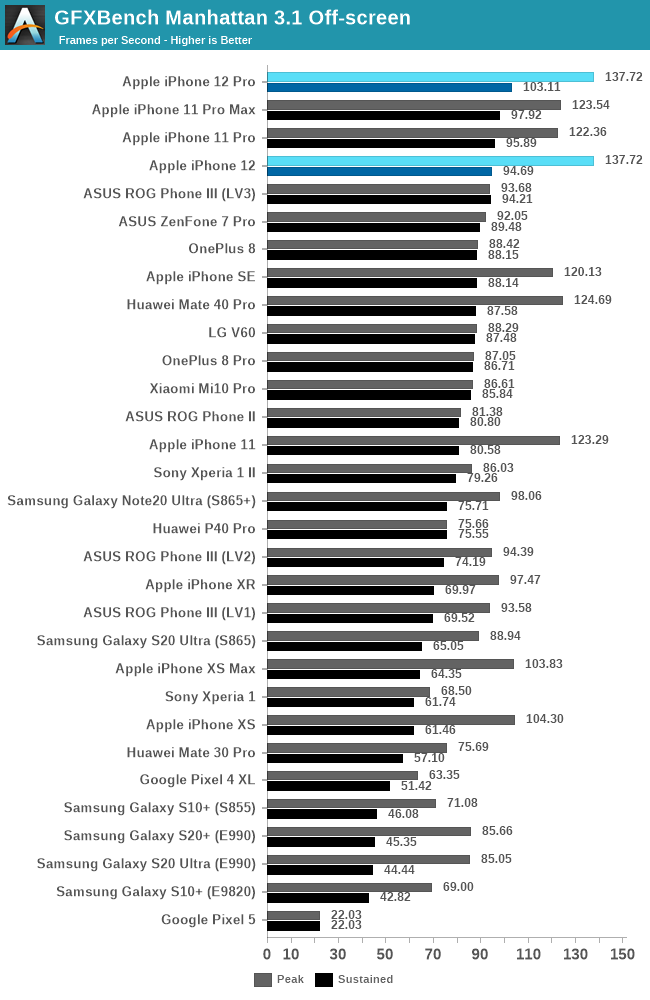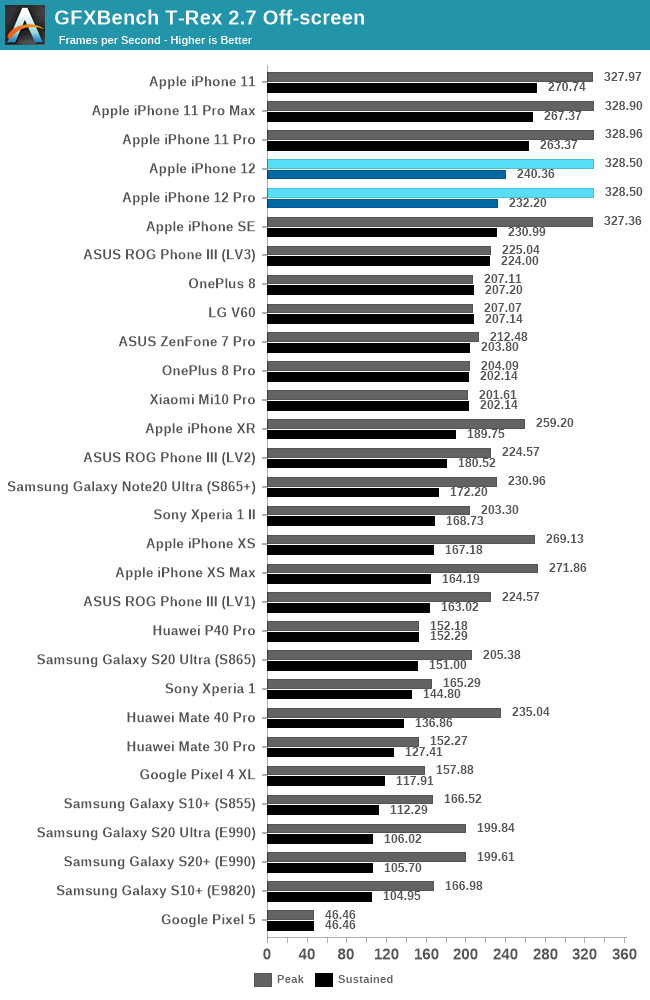The iPhone 12 & 12 Pro Review: New Design and Diminishing Returns
by Andrei Frumusanu on November 30, 2020 8:30 AM EST- Posted in
- Mobile
- Apple
- Smartphones
- Apple A14
- iPhone 12
- iPhone 12 Pro
GPU Performance & Power
GPU performance of the new A14 is something that wasn’t very clearly presented during the launch of the new iPhone 12 series. Apple had first introduced the A14 within the new iPad series where it had promised performance increases relative to the A12, not the previous generation A13, and with a bit of math this resulted into a translated 8.3% generational increase which is rather smaller than we had expected given Apple’s recent GPU trajectory over the years. Furthermore, this was also the first release where Apple compared itself to the Android SoC competition which is something the company doesn’t usually do. All these factored into some rather low expectations for the GPU of the A14 – so let’s see how that pans out in practice:

Starting off with Basemark GPU 1.2, we’re seeing a 17% increase in peak performance relative to the iPhone 11 Pro and the A13 chip, which is a nice upgrade, but doesn’t tell the whole story. In the sustained performance figure after 30 minutes of running and when the phone reaches a thermal equilibrium, we see a 45% drop in performance. In this instance, it looks like the iPhone 12 Pro reached a lower sustained performance level than the iPhone 11 Pro which isn’t a great start, but that might change with differing workloads.

In the Aztec High test, the iPhone 12’s fare a bit better in their sustained performances, with the new chip showing a 21% increase in performance generationally. The peak performance figure is only 11% higher but generally this isn’t the figure that is important for gaming experiences on iPhones.
| GFXBench Aztec High Offscreen Power Efficiency (System Active Power) |
||||
| Mfc. Process | FPS | Avg. Power (W) |
Perf/W Efficiency |
|
| iPhone 12 Pro (A14) 🔥 Throttled | N5 | 28.36 | 3.91 | 7.24 fps/W |
| iPhone 11 Pro (A13) 🔥 Throttled | N7P | 26.14 | 3.83 | 6.82 fps/W |
| iPhone 12 Pro (A14) ❄️ Peak | N5 | 37.40 | 5.57 | 6.64 fps/W |
| iPhone 11 Pro (A13) ❄️ Peak | N7P | 34.00 | 6.21 | 5.47 fps/W |
| Galaxy S20 Ultra (Snapdragon 865) | N7P | 20.35 | 3.91 | 5.19 fps/W |
| Mate 40 Pro (Kirin 9000) 🔥 Throttled | N5 | 27.37 | 5.39 | 5.07 fps/W |
| iPhone XS (A12) 🔥 Throttled | N7 | 19.32 | 3.81 | 5.07 fps/W |
| Reno3 5G (Dimensity 1000L) | N7 | 11.93 | 2.39 | 4.99 fps/W |
| iPhone XS (A12) ❄️ Peak | N7 | 26.59 | 5.56 | 4.78 fps/W |
| Mate 40 Pro (Kirin 9000) ❄️ Peak | N5 | 37.22 | 8.53 | 4.36 fps/W |
| ROG Phone III (Snapdragon 865+) | N7P | 22.34 | 5.35 | 4.17 fps/W |
| Mate 30 Pro (Kirin 990 4G) | N7 | 16.50 | 3.96 | 4.16 fps/W |
| Galaxy S20+ (Exynos 990) | 7LPP | 20.20 | 5.02 | 3.59 fps/W |
| Galaxy S10+ (Snapdragon 855) | N7 | 16.17 | 4.69 | 3.44 fps/W |
| Galaxy S10+ (Exynos 9820) | 8LPP | 15.59 | 4.80 | 3.24 fps/W |
Looking at the power consumption of the new phones, we see again that both the peak and throttled performance figures of the new chip isn’t all that much different to the previous generation, as we’re seeing roughly 8% better performance at almost the same power envelope of around 3.9W. The peak power figure of the new chip seems to have been reduced this generation and that’s very much a welcome change, and that’s where the efficiency sees the largest delta to the A13.

In the normal setting configuration of the Aztec test, we’re seeing again a 11% increase in sustained performance generationally, and a similar 12% boost in peak performance. These are good improvements but still a bit less than we had expected given the A14’s new process node and new GPU.
| GFXBench Aztec Normal Offscreen Power Efficiency (System Active Power) |
||||
| Mfc. Process | FPS | Avg. Power (W) |
Perf/W Efficiency |
|
| iPhone 12 Pro (A14) 🔥 Throttled | N5 | 77.44 | 3.88 | 19.95 fps/W |
| iPhone 12 Pro (A14) ❄️ Peak | N5 | 102.24 | 5.53 | 18.48 fps/W |
| iPhone 11 Pro (A13) 🔥 Throttled | N7P | 73.27 | 4.07 | 18.00 fps/W |
| iPhone 11 Pro (A13) ❄️ Peak | N7P | 91.62 | 6.08 | 15.06 fps/W |
| iPhone XS (A12) 🔥 Throttled | N7 | 55.70 | 3.88 | 14.35 fps/W |
| Galaxy S20 Ultra (Snapdragon 865) | N7P | 54.09 | 3.91 | 13.75 fps/W |
| iPhone XS (A12) ❄️Peak | N7 | 76.00 | 5.59 | 13.59 fps/W |
| Reno3 5G (Dimensity 1000L) | N7 | 27.84 | 2.12 | 13.13 fps/W |
| Mate 40 Pro (Kirin 9000) 🔥 Throttled | N5 | 63.56 | 5.37 | 11.84 fps/W |
| ROG Phone III (Snapdragon 865+) | N7P | 58.77 | 5.34 | 11.00 fps/W |
| Mate 40 Pro (Kirin 9000) ❄️ Peak | N5 | 82.74 | 7.95 | 10.40 fps/W |
| Mate 30 Pro (Kirin 990 4G) | N7 | 41.68 | 4.01 | 10.39 fps/W |
| Galaxy S20+ (Exynos 990) | 7LPP | 49.41 | 4.87 | 10.14 fps/W |
| Galaxy S10+ (Snapdragon 855) | N7 | 40.63 | 4.14 | 9.81 fps/W |
| Galaxy S10+ (Exynos 9820) | 8LPP | 40.18 | 4.62 | 8.69 fps/W |
The power figures showcase a similar generational movement, with a slight performance increase at a slight power decrease. It’s good progression but again not quite fulfilling our expectations of a new process node bump.

| GFXBench Manhattan 3.1 Offscreen Power Efficiency (System Active Power) |
||||
| Mfc. Process | FPS | Avg. Power (W) |
Perf/W Efficiency |
|
| iPhone 12 Pro (A14) 🔥 Throttled | N5 | 103.11 | 3.90 | 26.43 fps/W |
| iPhone 12 Pro (A14) ❄️ Peak | N5 | 137.72 | 5.63 | 24.46 fps/W |
| iPhone 11 Pro (A13) 🔥 Throttled | N7P | 100.58 | 4.21 | 23.89 fps/W |
| Galaxy S20 Ultra (Snapdragon 865) | N7P | 88.93 | 4.20 | 21.15 fps/W |
| iPhone 11 Pro (A13) ❄️Peak | N7P | 123.54 | 6.04 | 20.45 fps/W |
| iPhone XS (A12) 🔥 Throttled | N7 | 76.51 | 3.79 | 20.18 fps/W |
| Reno3 5G (Dimensity 1000L) | N7 | 55.48 | 2.98 | 18.61 fps/W |
| Mate 40 Pro (Kirin 9000) 🔥 Throttled | N5 | 87.31 | 4.98 | 17.54 fps/W |
| iPhone XS (A12) ❄️Peak | N7 | 103.83 | 5.98 | 17.36 fps/W |
| ROG Phone III (Snapdragon 865+) | N7P | 93.58 | 5.56 | 16.82 fps/W |
| Mate 40 Pro (Kirin 9000) ❄️Peak | N5 | 124.69 | 8.28 | 15.05 fps/W |
| Mate 30 Pro (Kirin 990 4G) | N7 | 75.69 | 5.04 | 15.01 fps/W |
| Galaxy S20+ (Exynos 990) | 7LPP | 85.66 | 5.90 | 14.51 fps/W |
| Galaxy S10+ (Snapdragon 855) | N7 | 70.67 | 4.88 | 14.46 fps/W |
| Galaxy S10+ (Exynos 9820) | 8LPP | 68.87 | 5.10 | 13.48 fps/W |
| Galaxy S9+ (Snapdragon 845) | 10LPP | 61.16 | 5.01 | 11.99 fps/W |
| Mate 20 Pro (Kirin 980) | N7 | 54.54 | 4.57 | 11.93 fps/W |
| Galaxy S9 (Exynos 9810) | 10LPP | 46.04 | 4.08 | 11.28 fps/W |
| Galaxy S8 (Snapdragon 835) | 10LPE | 38.90 | 3.79 | 10.26 fps/W |
| Galaxy S8 (Exynos 8895) | 10LPE | 42.49 | 7.35 | 5.78 fps/W |
Depending on the workload, the generational performance increases can be even smaller, as here in Manhattan the performance increase in a throttled state is only 3% better for the new A14 based iPhone, with also a minor power decrease at this state.

| GFXBench T-Rex Offscreen Power Efficiency (System Active Power) |
||||
| Mfc. Process | FPS | Avg. Power (W) |
Perf/W Efficiency |
|
| iPhone 12 Pro (A14) 🔥 Throttled | N5 | 260.28 | 4.08 | 63.97 fps/W |
| iPhone 11 Pro (A13) 🔥 Throttled | N7P | 289.03 | 4.78 | 60.46 fps/W |
| iPhone 12 Pro (A14) ❄️ Peak | N5 | 328.50 | 5.55 | 59.18 fps/W |
| iPhone 11 Pro (A13) ❄️ Peak | N7P | 328.90 | 5.93 | 55.46 fps/W |
| Galaxy S20 Ultra (Snapdragon 865) | N7P | 205.37 | 3.83 | 53.30 fps/W |
| Mate 40 Pro (Kirin 9000) 🔥 Throttled | N5 | 147.13 | 2.92 | 50.38 fps/W |
| iPhone XS (A12) 🔥 Throttled | N7 | 197.80 | 3.95 | 50.07 fps/W |
| ROG Phone III (Snapdragon 865+) | N7P | 224.48 | 4.92 | 45.60 fps/W |
| iPhone XS (A12) ❄️Peak | N7 | 271.86 | 6.10 | 44.56 fps/W |
| Galaxy 10+ (Snapdragon 855) | N7 | 167.16 | 4.10 | 40.70 fps/W |
| Reno3 5G (Dimensity 1000L) | N7 | 139.30 | 3.57 | 39.01 fps/W |
| Mate 40 Pro (Kirin 9000) ❄️ Peak | N5 | 235.04 | 6.11 | 38.46 fps/W |
| Galaxy S20+ (Exynos 990) | 7LPP | 199.61 | 5.63 | 35.45 fps/W |
| Mate 30 Pro (Kirin 990 4G) | N7 | 152.27 | 4.34 | 35.08 fps/W |
| Galaxy S9+ (Snapdragon 845) | 10LPP | 150.40 | 4.42 | 34.00 fps/W |
| Galaxy 10+ (Exynos 9820) | 8LPP | 166.00 | 4.96 | 33.40fps/W |
| Galaxy S9 (Exynos 9810) | 10LPP | 141.91 | 4.34 | 32.67 fps/W |
| Galaxy S8 (Snapdragon 835) | 10LPE | 108.20 | 3.45 | 31.31 fps/W |
| Mate 20 Pro (Kirin 980) | N7 | 135.75 | 4.64 | 29.25 fps/W |
| Galaxy S8 (Exynos 8895) | 10LPE | 121.00 | 5.86 | 20.65 fps/W |
Finally, T-Rex showcases no improvements on the part of peak performance figures, although it does lower power consumption, and sustained performance for some reason is lower on the newer generation iPhone, although again it showcases quite lower power consumption so it’s possible the new chip is mainly running on the efficiency CPU cores in this workload.
Reasonable Upgrades
Generally speaking, our concerns over Apple’s lacklustre marketing on the GPU side of things seem to have been warranted as the new A14 and the 5nm process node doesn’t seem to bring substantial gains this generation. Performance is a little higher, and efficiency has also gone up as well, but it’s nowhere near the levels of improvements that Apple had been able to achieve with the A12 and A13. On one side that’s pretty understandable as those two generations had made huge leaps, and on the other hand it was maybe unreasonable to expect Apple to continue to make such gigantic strides on every generation.
Overall, the new iPhone 12 devices and the A14 still offer the very best gaming performance of any smartphone out in the market, showcasing significantly better experiences than any other Android competitor, but it’s also not a major noticeable upgrade over the iPhone 11 series devices.










101 Comments
View All Comments
GC2:CS - Monday, November 30, 2020 - link
Displaymate says peak white is like 10% down compared to 11 Pro.11 Pro was 8% down from the XS but at higher max brightness the efficiency suffers (apple said 15% better isoperf).
That combined with the A14 would pretty much eliminate any fears of downgraded battery life. Unless you turn 5G on.
KPOM - Monday, November 30, 2020 - link
Still better than what iPhones can draw from normal Qi chargers.calleng - Monday, November 30, 2020 - link
All this talk about edges and surface of the phone is bull. Who uses an iphone without a proper case. Maybe apple should make them out of rubber.Andrei Frumusanu - Monday, November 30, 2020 - link
If we didn't care about the design then why bother with a heavier steel variant then? I don't care for cases for one and use all my phones naked.zanon - Monday, November 30, 2020 - link
calleng is completely off base but I do sympathize with Apple being tugged multiple ways here. If 70-80% of owners use a case, well, 20-30% naked is still a LOT. Tens of millions, and reviewers in particular always mention it, and it's what people feel in the store too. So it definitely matters to pay major attention to a quality naked phone experience. Yet that doesn't change a super majority using it with a case, and Apple can't possibly be completely ignoring that either."Why bother with a heavier steel variant then" though really is an interesting question give the noticeable weight difference. There are lots of other premium materials, titanium of course but also all sorts of alloys and even ceramics that Apple has worked with in the past. Steel is certainly really versatile and can be very tough, but it's still a curious choice for a company that has tended to pay a lot of attention to weight and hand feel. As you say in the review it's genuinely debatable if it even is more "premium" here, and it's not like Apple doesn't have serious materials chops. They have high end titanium case options for their watches as well.
cha0z_ - Tuesday, December 1, 2020 - link
The last pools I saw on the subject (this summer), it was 50% using their phones naked and 50% with a case. ;) the pool had around 40 000 voters.cha0z_ - Tuesday, December 1, 2020 - link
Same, used all of my phones totally naked (no case, no screen protector) - all in perfect condition.FunBunny2 - Tuesday, December 1, 2020 - link
from what I gather, most cracked screens are from butt compression due to carrying in back pocket. spongy rubber-ish case won't stop that.iphonebestgamephone - Tuesday, December 1, 2020 - link
Look harder and youll see how its not perfect.Unashamed_unoriginal_username_x86 - Tuesday, December 1, 2020 - link
I know it's not as comfortable or sexy, but I hope you put something on when you go outside. I don't want you getting arrested!